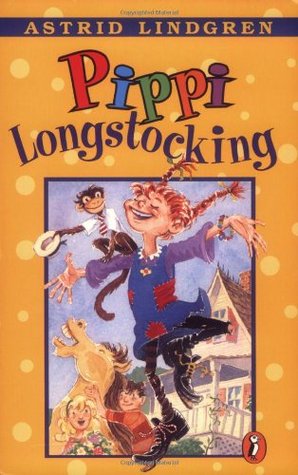Flashback of a Flashback! Seventy years old and still going strong! . . .
Posted by Stephanie Whelan
To celebrate the 70th anniversary of one of my favorite heroines, I’m reposting my earlier Flashback piece on Pippi! Enjoy!
You’re a super strong girl who lives with a horse and a monkey, filling your days with all kinds of adventures–defying the authorities and flummoxing criminals. Do you remember:

Pippi Longstocking by Astrid Lindgren, translated by Florence Lamborn (Puffin, c1945)
I don’t remember exactly how old I was when I first encountered this red-haired rebel and challenger of authority, but I knew I liked her. Pippi Longstocking, the nine-year-old girl whose mother died and whose father is away at sea, lives on her own in her rambling house, Villa Villekulla. She has has a horse living on a porch, and shares her home with a monkey . . . and has a suitcase full of gold coins. Oh and did I mention she’s super strong? Pippi tells wild stories that may–or may not be true, but she unrelenting in her tale-tellings. She’s full of good-humored mischief and has enough impertinent questions to drive any humorless authority figure batty. She was probably the first strong female protagonist I encountered–one who lived outside the rules of society, defied any need for protection, and did it all with a warm heart and a cheerful disposition.

This is one time when “strong female character” really does apply. Because Pippi is super strong–super hero strong in fact. She may not being going out to fight crime in spandex, but she probably could if she wanted to. She’s a girl who does exactly what she wants, lives how she wants and is perfectly, perfectly comfortable in her own skin. Not too bad a role model if I do say so myself.
Originally written in Swedish, Pippi was the brainchild of author Astrid Lindgren that started as a story for her daughter who was home sick from school. That story evolved into a character who is beloved around the world and has remained a classic staple of children’s literature for decades. The book has been published in 64 languages and made into a number of different movies and televisions series. While there was a movie made in the US in 1988 (The New Adventures of Pippi Longstocking) the most iconic Pippi was played by Inger Nilsson in the Swedish television series Pippi Longstocking (1969) . In the late 1990s, a lightweight animated television series was created by Nelvana that followed Pippi’s adventures from the books–it’s still available on certain children’s cartoon channels like Qubo. Sadly, Pippi comes across as a little too conventional in the cartoon to really work well.
Interesting tidbit of trivia I found: apparently Hayao Miyazaki had expressed interest in creating an anime feature based on the books back in 1971, and had gone so far as to visit Sweden and the author. The movie was never made, though some watercolor concept stills were created that can be seen here at Comics Alliance. It seems that ultimately Lindgren turned down the offer . . . but knowing Miyazaki’s love of strong female protagonists (and red heads), it’s too bad this was never taken further.
There are two more chapter books of Pippi’s adventures that can usually be found on the shelves: Pippi Goes on Board (1946), and Pippi in the South Seas (1948). These continued our protagonists’ adventures at sea and reuniting with her papa once more–while they’re not as popular as the original story, they can usually be found on library shelves. The later books–particularly the South Seas adventure does come with a bucket load of nonPC native descriptions that may rankle more modern readers.
But that’s not the end of Pippi! There were also several shorter, picture book stories that were translated into English, and a comic book series that’s only recently become available in the US.

Astrid Lindgren wrote more than the Pippi books, although they’re less well known in the States. The other one you might spot on the shelves in the US is Ronia, the Robber’s Daughter (1981). I’ve yet to read this one myself, but intend to. Especially since the book features the marvelous illustrations of Trina Schart Hyman. .
Upon reflection, this was probably the first translated work of fiction I read as a child. I wasn’t actually aware it was translated at the time, and only figured that out as an adult. But I did recognize that the story took place in a different country. I often wished I could go visit Villa Villekulla and share dinner with Pippi.
Any other Pippi fans out there? Comments welcome!
About Stephanie Whelan
I'm a children's librarian with a life-long love of all things science fiction and fantasy.Posted on May 22, 2015, in General Posts and tagged Authors, Books, Children's Books, Children's Literature, Children's Movies, fantasy, kidlit, Libraries, Lists, literature, MG Books, Middle-Grade Fiction, Reading, reviews, series. Bookmark the permalink. 1 Comment.
Pingback: My 400th Post: What Brought Me This Far: 100 Books in my Blood | Views From the Tesseract